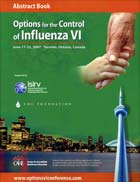[ 抗インフルエンザウイルス ]
- プロポリス含有フラボノイド類の抗インフルエンザウイルス作用
- 抗インフルエンザウイルス活性を有するプロポリスAF-08の活性物質の探索
- 抗インフルエンザウイルス活性を有するプロポリスAF-08の活性物質の探索
- プロポリスAF-08の抗インフルエンザウイルス活性画分の探索とその作用機序解析
- プロポリスAF-08の抗イフルエンザウイルス作用機序解析とその活性画分の検討
- ブラジル産プロポリスAF−08の抗インフルエンザウイルス作用機序の検討
- Anti-influenza virus activity of propolis in vitro and its efficacy against influenza infection in mice
- プロポリスAF-08の抗ウイルス効果
- プロポリス(AF−08)の抗インフルエンザ作用
- Anti-influenza virus activity of propolis in vitro and its efficacy against influenza infection in mice
- プロポリスの抗インフルエンザウイルス作用
- インフルエンザ感染症に対するプロポリスの治療効果
- インフルエンザウイルス感染マウスモデルを用いたプロポリスの抗ウイルス活性評価
- インフルエンザウイルス感染に対するプロポリスの病態改善効果
Anti-influenza virus activity of propolis in vitro and its efficacy against influenza infection in mice
2007年 国際インフルエンザ学会
- Shimizu, A Hino, W Watanabe, M Kurokowa
Department of Biochemistry, School of pharmaceutical Sciences, Kyushu University of Health and Welfare, Nobeoka, Miyazaki. Japan - YK park
Department of Food Science, College of Food Engineering and Jnstitute of Chemistry, State University of Campinas, Campinas, Sao paulo, Brazil - S Tsutsumi
Amazonfood Ltd., Setagaya, Tokyo, Japan
Propolis has been used worldwide as a folk medicine and a dietary supplement to maintain or improve human hearth since ca. 300BC.
It is a resinous material collected from various plant sources by honeybees and contains many kinds of compounds that vary in the areas collected. Propolis has been repoted to exhibit various biological activities.Its anti-influenza virus activty was also reported in an invitro−study.
However, the anti−influenza virus activity in vivo is not clear. ln this study,we examined the anti−influenza activity of Brazilian propols in vitro and in vivo and found that one of 13 propolis exhibited therapeutic efficacy against influenza virus infection in mice.Thirteen propols used were collected by Africanized Apis mellifera bees in different parts of southern BraziI.
extracted with ethanol, and dried. The 13 ethanol extracts were screened for their antiviral activity against influenza A/PR/8/34(H1N1) virus by the plaque reduction assay using Madin−Darby canine kidney(MDCK) cells. The cytotoxicity of extracts was evaluated by the typan blue edye exclusion assay and MTT assay using MDCK cells. Among the13, an extract AF-08) exhibited a potent anti-influenza virus activity and did not inhibit influenza virus adsorption to cells. AF−08 also possessed antiviral actovotties against influenza A/lshikawa/7/82(H3N2).
B/Fukushima/15/93, and oseltamivir-resistant A/PR/8/34(H1N1) viruses. AF−08 was further examined for its therapeutic efficacy in an intranasal influenza virus infection model in mice. lts oral administration (0.4, 2, and 10 mg/kg three times daily for 7 days) prolonged the survival times of infected mice in a dose-dependent manner without toxicity. The dose of 10 mg/kg was significantlye effctive in reducing the body weight loss of infected mice and virus yields in the bronchoalveolar lavage fluids of lungs compared with those of controIs.These anti-influenza effcacies at the 10 mg/kg corresponded to that of oseltamivir at 1 mg/kg twice daily as the dose for mice corresponding to a human dose. Thus, a Brazilian propolise AF-08. was a possible candidate for anti-influenza dietary supplement and suggested to contain some compound that shows differentantt anti-influenza action from oseltamivir.

